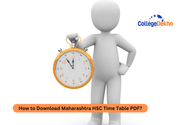- AP Intermediate Commerce Syllabus 2025-26 for Economics
- AP Intermediate Commerce Syllabus 2025-26
- AP Intermediate Commerce Syllabus 2025-26 for English
- AP Intermediate Commerce Syllabus 2025-26 for Civics
- AP Intermediate Commerce Syllabus 2025-26 for Mathematics II A
- AP Intermediate Commerce Syllabus 2025-26 for Mathematics II B
- Faqs


Never Miss an Exam Update
AP Intermediate Commerce Syllabus 2025-26 is divided into CEC and MEC groups. The CEC syllabus is for students who have opted for subjects like Civics, Economics, and Commerce, and the MEC syllabus is for Math, Economics, and Commerce. Apart from that, you can opt for the optional subjects as well. There are no changes expected to be made in the syllabus this year, so you can continue using old books or NCERT books to prepare. For the commerce stream subjects, the theory paper will be conducted for 100 marks. The question paper will consist of MCQs, very short answer type questions, short answer type questions, and long answer type questions. AP Intermediate Commerce Syllabus 2025-26 for all the major subjects has been provided here. You can go through the article to learn more.
AP Intermediate Commerce Syllabus 2025-26 for Economics
A total of 10 chapters are included in the Economics subject. Check out the information about the AP Intermediate Economics Syllabus 2025-26 from the table given below:
S. No. | Chapter Name | Topics |
|---|---|---|
1 | Economic Growth and Development | 1.0 Introduction 1.1 Economic growth 1.2 Economic Development 1.3 Differences Between Economic Growth and Development 1.4 Classification of the World Countries 1.5 Indicators of Economic Development 1.6 Determinants of Economic Development 1.7 Characteristic features of Developer Countries 1.8 Characteristic features of developing countries with special reference to India |
2 | Population and Human Resources Development | 2.0 Introduction 2.1 Theory of Demographic Transition 2.2 World Population 2.3 Causes of Rapid Growth of Population in India 2.4 Occupational distribution of Population of India 2.5 Meaning of Human Resources Development 2.6 Role of Education and Health in Economic Development 2.7 Human Development Index (HDI) |
3 | National Income | 3.0 Introduction 3.1 Trends in the growth of India’s National Income 3.2 Trends in distribution of national income by industry origin 3.3 Share of Public Sector and Private Sector in Gross Domestic Product 3.4 Share of Organised and Un-organised Sector in Net Domestic Product 3.5 Income Inequalities 3.6 Causes of Income Inequalities 3.7 Measures to control income inequalities 3.8 Unemployment in India 3.9 Poverty 3.10 Micro Finance – Eradication of Poverty |
4 | Agriculture Sector | 4.0 Introduction 4.1 Importance of agriculture in India 4.2 Features of Indian agriculture 4.3 Agriculture Labour in India 4.4 Land Utilization Pattern in India 4.5 Cropping pattern in India 4.6 Organic Farming 4.7 Irrigation facilities in India 4.8 Productivity of agriculture 4.9 Land holdings in India 4.10 Land reforms in India 4.11 Green Revolution in India 4.12 Rural credit in India 4.13 Rural Indebtedness in India 4.14 Agricultural Marketing |
5 | Industrial Sector | 5.0 Introduction 5.1 Significance of the Indian Industrial Sector in the Post-Reform Period 5.2 Industrial Policy Resolution 1948 5.3 Industrial Policy Resolution 1956 5.4 Industrial Policy Resolution 1991 5.5 National Manufacturing Policy 5.6 Disinvestment 5.7 National Investment Fund (NIF) 5.8 Foreign Direct Investment 5.9 Special Economic Zones (SEZs) 5.10 Causes of industrial backwardness in India 5.11 Small Scale Enterprises (MSMEs) 5.12 Industrial Estates 5.13 Industrial Finance in India 5.14 Industrial Development under the Five-Year Plans in India |
6 | Tertiary Sector | 6.0 Introduction 6.1 Importance of the Services Sector 6.2 India’s Services Sector 6.3 State-wise Comparison of Services 6.4 Infrastructure Development 6.5 Tourism 6.6 Banking and Insurance 6.7 Communication 6.8 Science and Technology 6.9 Software Industry in India |
7 | Planning and Economic Reforms | 7.1 Meaning of Planning 7.2 NITI Aayog 7.3 Five-Year Plans in India 7.4 XII Five-Year Plan 7.5 Regional Imbalances 7.6 Role of Trade in Economic Development 7.7 Economic Reforms in India 7.8 GATT 7.9 WTO |
8 | Environment and Sustainable Economic Development | 8.1 Environment 8.2 Economic Development 8.3 Environment and Economic Linkages 8.4 Harmony between Environment & Economy |
9 | Economy of Andhra Pradesh | 9.1 History of Andhra Pradesh 9.2 Characteristic features of A.P. Economy 9.3 Demographic features 9.4 Occupational distribution of labour 9.5 Health Sector 9.6 Education 9.7 Environment 9.8 Agricultural Sector 9.9 Industrial Sector 9.10 Service and Infrastructure sector 9.11 Information and Technology 9.12 Tourism 9.13 Andhra Pradesh and Welfare Programmes/Schemes |
10 | Economic Statistics | 10.1 Measures of Dispersion 10.2 Definitions of Dispersion 10.3 Importance of Measuring Variation 10.4 Properties of a good measure of variation 10.5 Methods of studying variation 10.6 Measures of Dispersion for Average 10.7 Lorenz Curve 10.8 Correlation 10.9 Index Numbers 10.10 Weighted Aggregation Method |
AP Intermediate Commerce Syllabus 2025-26
A total of five chapters are included in the syllabus for Commerce. You can refer to the topics included in each chapter from the table given below:
Chapters | Topics |
|---|---|
Chapter I: Entrepreneurship | 1.1 Entrepreneur 1.2 Entrepreneurship |
Chapter II: Domestic and International Trade | 2.1 Domestic Trade 2.2 International Trade |
Chapter III: Business Services | 3.1 Meaning and characteristics 3.2 Distinction between services and goods 3.3 Types of business services |
Chapter IV: Financial Markets | 4.1 Financial Markets 4.2 Money Market 4.3 Capital Market 4.4 Distinguish between Money Market and Capital Market 4.5 Stock Exchange 4.6 SEBI |
Chapter – V: Consumer Protection | 5.1 Introduction 5.2 Concept of Consumer Protection 5.3 Importance of Consumer Protection 5.4 Consumer Rights 5.5 Consumer Responsibilities 5.6 Ways and Means of Consumer Protection 5.7 Legal Protection to Consumers (Various Acts) 5.8 Redressal Agencies under the Consumer Protection Act, 1986 |
AP Intermediate Commerce Syllabus 2025-26 for English
The English syllabus includes prose, poetry, non-detailed text, and a grammar portion. Check the AP Intermediate English Syllabus 2025-26 here:
Chapter/Section Name | Topics |
|---|---|
Prose | Of Studies - Francis Bacon The Secret of Work - Swami Vivekananda J C Bose - Aldous Huxley In Celebration of Being Alive - Dr Christian Barnard Learning from the West - N R Narayana Murthy |
Poetry | On His Having Arrived at the Age of Twenty-Three - John Milton The Tables Turned - William Wordsworth The Builders - Henry Wadsworth Longfellow Any Woman - Katharine Tynan A Challenge to Fate - Sarojini Naidu |
Nondetailed Text | About the Adventures of Tom Sawyer List of Characters Chapters 1 to 8 Glossary About the Author Summary Major Characters Comprehension Passages Essay Questions |
Study and Communication Skills | Conversation Practice Letter Writing Word Stress Reading Comprehension Interpretation of Non-verbal Information The Language of Advertisements Vocabulary Describing a Process Note Making Curriculum Vitae Completing a Form |
AP Intermediate Commerce Syllabus 2025-26 for Civics
Civics is one of the subjects that you can choose in the Commerce stream. Check out the chapters included in the syllabus from the table given below:
S. No. | Topic |
|---|---|
1 | The Constitution of India |
2 | Fundamental Rights and Directive Principles of State Policy |
3 | Union Executive |
4 | Union Legislature |
5 | Union Judiciary |
6 | State Executive |
7 | State Legislature |
8 | State Judiciary |
9 | Union-State Relations |
10 | Local Governments in India |
11 | Elections and Representation |
12 | Political Parties |
13 | Recent Development in Andhra Pradesh and India |
AP Intermediate Commerce Syllabus 2025-26 for Mathematics II A
Mathematics is another subject that you can choose in the Commerce stream. Check out the AP Intermediate Mathematics Syllabus 2025-26 from the table given below:
S. No. | Topic |
|---|---|
1 | Chapter 1: Complex Numbers 1.1 Complex number as an ordered pair of real numbers 1.2 Representation in the form a+ib 1.3 Modulus and Amplitude – Illustrations 1.4 Geometrical and Polar representation – Argand diagram |
2 | Chapter 2: De Moivre’s Theorem 2.1 Theorem – Integral and Rational Indices 2.2 nth roots of unity – Geometrical Interpretations |
3 | Chapter 3: Quadratic Expressions 3.1 Equations in one variable 3.2 Sign, Change of signs, Max/Min 3.3 Quadratic Inequations |
4 | Chapter 4: Theory of Equations 4.1 Roots and Coefficients relations 4.2 Solving using known root relations 4.3 Complex roots in conjugate pairs 4.4 Transformation & Reciprocal equations |
5 | Chapter 5: Permutations and Combinations 5.1 Fundamental Principles – Linear & Circular 5.2 Permutations of n dissimilar items 5.3 Repetitions allowed 5.4 Circular permutations 5.5 Constant repetitions 5.6 Combinations – Definitions and Theorems |
6 | Chapter 6: Binomial Theorem 6.1 Positive integral index 6.2 Rational index 6.3 Approximations using Binomial Theorem |
7 | Chapter 7: Partial Fractions 7.0 Rational Fractions 7.1 Non-repeated linear factors 7.2 Repeated and/or non-repeated linear factors 7.3 Irreducible factors |
8 | Chapter 8: Measure of Dispersion 8.1 Range 8.2 Mean Deviation 8.3 Variance & Standard Deviation (ungrouped/grouped) 8.4 Coefficient of Variation; analysis with same mean but different variances |
9 | Chapter 9: Probability 9.1 Random Experiments and Events 9.2 Classical & Axiomatic definitions; Addition Theorem 9.3 Independent/Dependent events, Conditional Probability, Multiplication Theorem, Bayes’ Theorem |
10 | Chapter 10: Random Variables and Probability Distributions 10.1 Random Variables 10.2 Binomial and Poisson distributions |
AP Intermediate Commerce Syllabus 2025-26 for Mathematics II B
A total of 8 chapters are included in the syllabus for Mathematics B. Check out the detailed syllabus from the table given below:
S. No. | Topic |
|---|---|
1 | Chapter 1: Circle 1.1 Equation, standard form, centre & radius 1.2 Position of a point, tangent definition 1.3 Condition for line to be tangent 1.4 Chord of contact & polar 1.5 Relative positions of two circles |
2 | Chapter 2: System of Circles 2.1 Angle between two intersecting circles 2.2 Radical axis of two circles |
3 | Chapter-3: Parabola 3.1 Conic sections 3.2 Tangent & normal at a point on parabola |
4 | Chapter-4: Ellipse 4.1 Standard form, parametric equations 4.2 Tangent & normal at a point on ellipse |
5 | Chapter-5: Hyperbola 5.1 Standard form, parametric equations 5.2 Tangent & normal at a point on hyperbola |
6 | Chapter-6: Integration 6.1 Inverse of differentiation, standard forms, properties 6.2 Substitution method (algebraic, exponential, logarithmic, trigonometric, inverse trig.) 6.2(A) Integration by substitution (algebraic/trig.) 6.2(B) Integration by parts (exp., log., inverse trig.) 6.3 Partial fractions 6.4 Reduction formulae |
7 | Chapter 7: Definite Integrals 7.1 Limit of a sum 7.2 Area interpretation 7.3 Fundamental Theorem of Integral Calculus 7.4 Properties 7.5 Reduction formulae 7.6 Applications to areas |
8 | Chapter 8: Differential Equations 8.1 Formation, degree & order 8.2 Solving methods: (a) Variables separable (b) Homogeneous (c) Non-homogeneous (d) Linear differential equations |
Make sure to download only the latest AP Intermediate Commerce Syllabus 2025-26 from the official website to catch all the minor changes made to the curriculum. To prepare well for the exams, try to buy the latest editions of NCERTs and books as prescribed by the Board of Intermediate Education, Andhra Pradesh.
Are you feeling lost and unsure about what career path to take after completing 12th standard?
Say goodbye to confusion and hello to a bright future!

FAQs
To pass the AP intermediate, you need to score at least 35% marks in each subject included in the curriculum.
AP Intermediate Commerce Syllabus 2025-26 includes 4 main subjects, namely Civics, Mathematics, Economics, and Commerce, along with one language subject, which can be Urdu, English, or Telugu, and one additional subject can be chosen by the students.
To complete the AP Intermediate Commerce Syllabus 2025-26, you will need around 6 months, so make sure to start your preparation at the very beginning of the academic year to have enough time for an effective revision during the last month.
There are three main subjects included in the AP Intermediate Commerce Syllabus 2025-26, along with that, you are required to choose one language among Telugu, Urdu, English, or Hindi.
Right now, the latest AP Intermediate Commerce Syllabus 2025-26 is not available on the official website of the Board of Intermediate Education; however, you can continue using oil syllabus to prepare for the exams as there are little to no changes expected to be made to the curriculum.
Was this article helpful?



















